While October flows remain strong, at over $20 billion, it seems unlikely that this year will close out as the biggest ever for ETFs. But with over $177 billion in net new money year to date, I don’t think anyone’s crying in their soup.
On the topline, virtually every major asset class had flows:
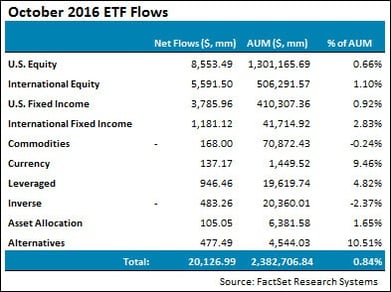
The big picture, however, masks some pretty seismic shifts among investors inside these segments. Let’s start this time with looking at where the money left.
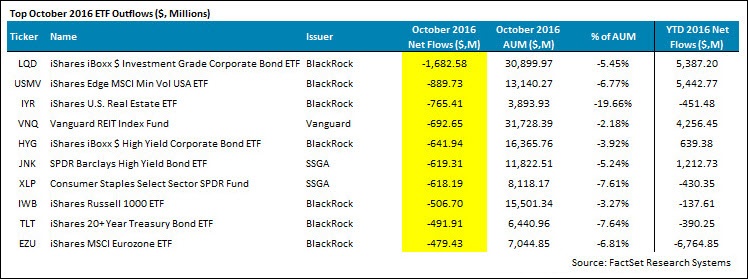
The headline here is clear: investors fled corporate bonds in droves for the first time in a while. LQD, HYG, and JNK all had big outflows after having otherwise great years. At the same time, investors pulled back on their exposure to long treasuries and the entire real estate sector.
What do all of these things have in common? Yield. Is it possible we’re seeing investors tire of taking on more and more risk just to eek out another small yield? So where’s all that money going?
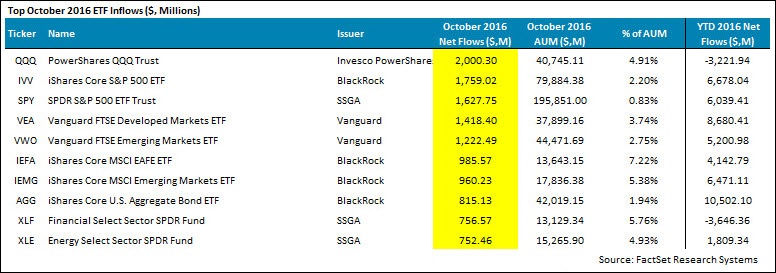
The answer is: the most traditional places possible. With the exception of the two Select Sector SPDRs at the bottom, this list reads like a playbook for low cost risk-on exposure. That four of the funds here are from the iShares Core series suggests that their recent rash of price cuts may be having just the desired effect.
I find the sector chart particularly interesting this month:
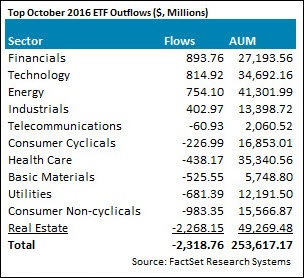
First, note that the whole complex of sector ETFs is down by the same amount as real estate. My belief is that this showing both investors who were surprised to find that they owned real estate in the wake of distributions from the Financials ETFs, and thus sold, and folks getting tired of yield hunting in what is a risky asset class. What remains, then, is the more traditional “sector rotation” money we tend to see as stable.
In this case, we see a strong vote for Energy, Tech and Financials (the growthier, momentum sectors) and a walk away from the utilities, materials, and non-cyclicals (generally considered more safety plays). This trend is further evidence of a real “risk on” shift in investor sentiment.
Tale of the Tape
At the issuer level, I’ve sorted this month by flows, not assets, to point a few things out.
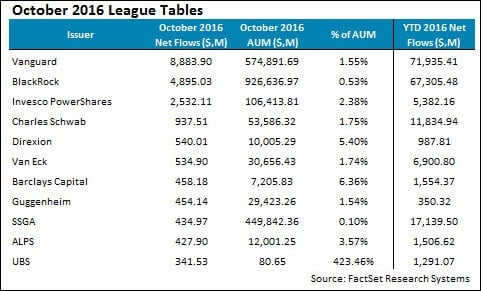
The top of the chart’s not surprising – the big guys keep getting bigger. But look who’s filling up the bottom half of the chart: Guggenheim, Van Eck, Schwab. These “mid-tier” players have been having great traction with very specific strategies. Van Eck has been reaping the benefits of the return to gold, with GDX, and rounded that out with a few other stories: a solid preferred fund in PFXF and a strong year for EMLC. By contrast, Guggenheim reversed a slow year with strong showings in flagship products like Equal Weight S&P (RSP) and a pickup in its Euro and Pound Currency products (FXE and FXB).
Meanwhile, Schwab just continues to grind in money, month after month, into its core product line. All but four of its 21 ETFs had positive flows last month, almost all over them over $20 million. For my money, that just signals continued dominance of Schwab's roboadvisor platform.
And see where SSgA, the third of the big three, is in the list? Eighth place. SSgA’s fortunes swing on the back of just a few mega funds; SPY, at almost $200 billion under management, is nearly half the entire complex. GLD is another $40 billion, and the sector suite is another $90 billion. While SSgA has had interesting product launches that for other firms would be considered huge successes, like the DoubleLine Tactical Total Return ETF (TOTL), with over $1.2 billion in year-to-date flows, it’s hard for that number to move the needle against the internal giants.
All of this goes to say: I think there’s still a lot of room for innovation in the ETF market, and it warms my heart to see some of the “middle tier” having a few moments in the sun.
